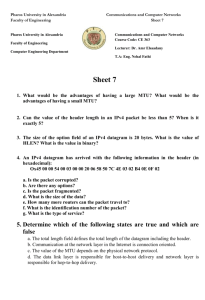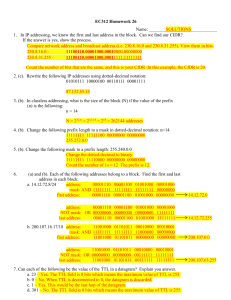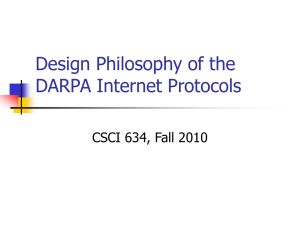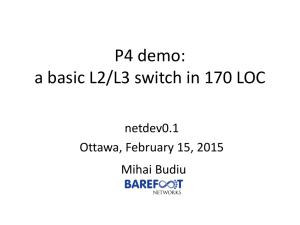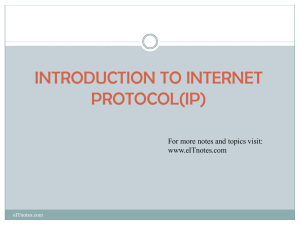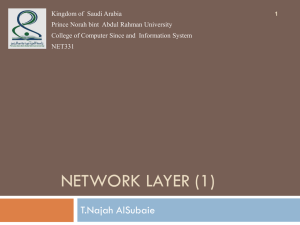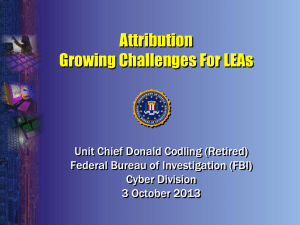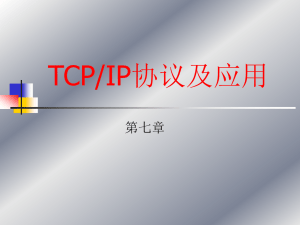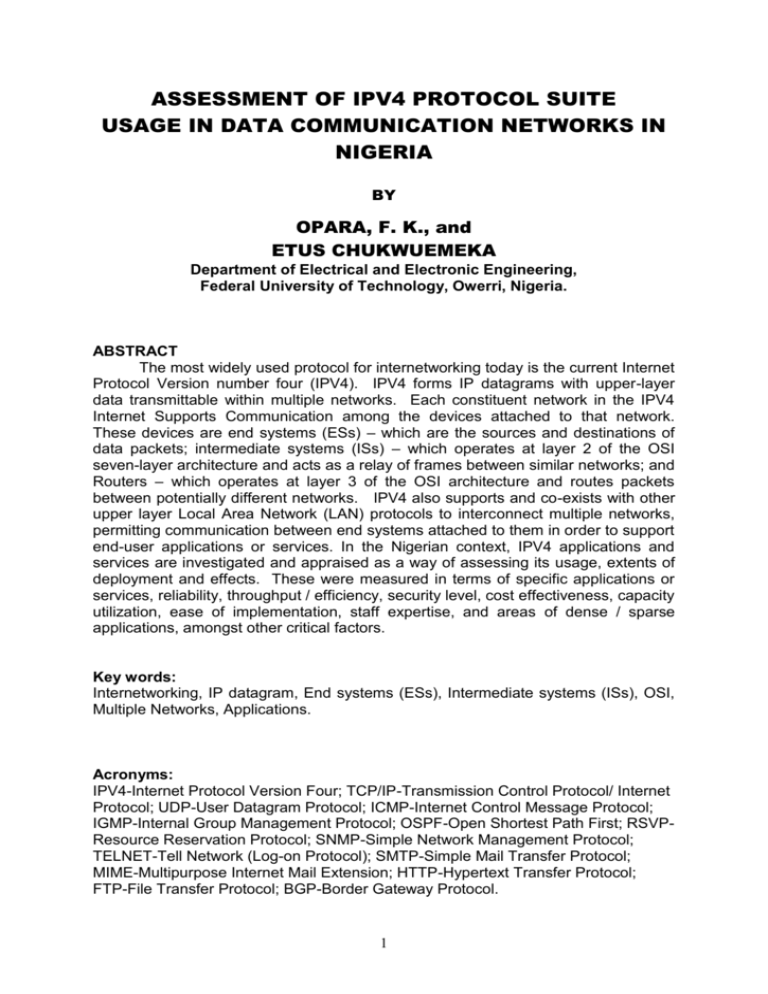
ASSESSMENT OF IPV4 PROTOCOL SUITE
USAGE IN DATA COMMUNICATION NETWORKS IN
NIGERIA
BY
OPARA, F. K., and
ETUS CHUKWUEMEKA
Department of Electrical and Electronic Engineering,
Federal University of Technology, Owerri, Nigeria.
ABSTRACT
The most widely used protocol for internetworking today is the current Internet
Protocol Version number four (IPV4). IPV4 forms IP datagrams with upper-layer
data transmittable within multiple networks. Each constituent network in the IPV4
Internet Supports Communication among the devices attached to that network.
These devices are end systems (ESs) – which are the sources and destinations of
data packets; intermediate systems (ISs) – which operates at layer 2 of the OSI
seven-layer architecture and acts as a relay of frames between similar networks; and
Routers – which operates at layer 3 of the OSI architecture and routes packets
between potentially different networks. IPV4 also supports and co-exists with other
upper layer Local Area Network (LAN) protocols to interconnect multiple networks,
permitting communication between end systems attached to them in order to support
end-user applications or services. In the Nigerian context, IPV4 applications and
services are investigated and appraised as a way of assessing its usage, extents of
deployment and effects. These were measured in terms of specific applications or
services, reliability, throughput / efficiency, security level, cost effectiveness, capacity
utilization, ease of implementation, staff expertise, and areas of dense / sparse
applications, amongst other critical factors.
Key words:
Internetworking, IP datagram, End systems (ESs), Intermediate systems (ISs), OSI,
Multiple Networks, Applications.
Acronyms:
IPV4-Internet Protocol Version Four; TCP/IP-Transmission Control Protocol/ Internet
Protocol; UDP-User Datagram Protocol; ICMP-Internet Control Message Protocol;
IGMP-Internal Group Management Protocol; OSPF-Open Shortest Path First; RSVPResource Reservation Protocol; SNMP-Simple Network Management Protocol;
TELNET-Tell Network (Log-on Protocol); SMTP-Simple Mail Transfer Protocol;
MIME-Multipurpose Internet Mail Extension; HTTP-Hypertext Transfer Protocol;
FTP-File Transfer Protocol; BGP-Border Gateway Protocol.
1
1.0
INTRODUCTION
Before the development of the Internet Protocol Version Four (IPV4) – a
layered structure concept of a global addressing standard for data communication
over mixed networks and technologies covering Local Area Networks (LANs),
Metropolitan Area Networks (MANs), and Wide Area Networks (WANs); there
existed dedicated and customized single-work protocols. Examples include
broadcast and switched Ethernet LAN protocols, asynchronous transfer mode (ATM)
protocol, Fibre Channel Protocol, Open Systems Interconnection (OSI) protocol and
so on. However, combining several computer protocols networks each with its own
dedicated purposes together would be a nightmare or disaster if the interactions
between them were not clearly defined. Hence, the development of the layered
structure concept – IPV4 (Stallings, 2000), to help keep each protocol in its place
and to also define the manner of Interactions between the protocols, thus becoming
a global addressing scheme. It is essentially a protocol for communication between
communication protocols; with the first of its kind being the Internet Protocol version
four (IPV4). IPV4, which is an internetworking protocol (Internet protocol for short),
assumes the first of the Internet protocol standards upon which the global Internet
builds and thrives.
IPV4 is a 32-bit address space protocol suite also known as the TCP / IP
(Transmission Control Protocol/Internet Protocol) suite version number four with five
layers:
Application layer – providing communication between processes or
applications or separate hosts; Transport layer – providing end-to-end data transfer;
Internet layer – concerned with routing data from source to destination through one
or more networks connected to routers; Network access layer – concerned with the
logical interface between an end system and a network; and physical layer – which
defines characteristics of transmission medium, signaling rate, and signal encoding
scheme; and that with spaces for about 4.2 billion hosts [Wright and Stevens 1995].
As a protocol version, IPV4 contains the Protocol Data Unit (PDU), Service Data Unit
(SDU), and Protocol Control Information (PCI) with syntax, semantics and timing
elements, all put together to serve the purpose of data transfer and management
controls. Hence, it supports and coexists with other upper-layer protocols (see figure
3) to enable the hosts send and receive data across computer networks to and fro
end systems (hosts), or in the case of hosts on diverse networks, to and fro a router /
routers. IPV4 is implemented in all of the end systems and routers concerned, acts
2
as a relay to move a blocks of data (executable binaries, American Standard for
Information Interchange (ASCII) texts, postscripts and so on), from one host through
one or more routers to another host, and keeps track of the blocks of data to assure
that all are delivered reliably to the appropriate applications.
IPV4, as the first global Internet addressing protocol base / scheme for the
Internet mixed Networks, was originally created for the purpose of serving the
educational and scientific community (Huitema, 1995). However the Internet was
such a good idea that it quickly expanded and has now become far reaching to have
touched almost every facet of the global community – IP telephony, movies, e-mails,
e-commerce and so on. For successful Internet communications, every entity in the
overall system must have unique addresses. Actually, two levels of addressing are
needed. Each host on a network must have a unique global Internet address - this
allows the data to be delivered to the proper host. Each process within a host must
have an address that is unique within the host - this allows the end-to-end protocol
(TCP) to deliver data to the proper process. These latter addresses are known as
ports [Halsall, 1996].
This paper showcased the IPV4 protocol format, addressing format, Datagram
format, Interfacing upper layer protocols and its standard applications – illustrated
using a typical case within the Nigerian Internet industry. Finally, this paper
investigated and appraised IPV4 standard applications deployment extents and
effects, as a way of assessing its usage in Nigeria.
2.0
OVERVIEW OF IPV4 PROTOCOL SUITE
IPV4 as the protocol used by machines to form today’s Internet has 32-bit
address spaces for about 4.2 billion hosts. As the protocol between IP entities IPV4
is best descried with reference to the IP datagram format [Stallings, 2002]; as shown
in figure 1 below. The fields are as follows:
Version (4 bits): Indicates Version number, to allow evolution of the
protocol.
Internet header length (IHL) (4 bits): length of header in 32-bit words. The
minimum value is five, for a minimum header length of 20 octets.
Type of service (8 bits): specifies reliability, precedence, delay, and
throughput parameters.
Total length (bits): Total datagram length, in octets.
3
Identification (16 bits): A sequence number that, together with the source
address, destination address, and user protocol, is intended to identify a
datagram uniquely.
Thus, this number should be unique for the
datagram’s source address, destination address and user protocol for the
time during which the datagram will remain in the Internet.
Flags (3 bits): Only two of the bits are currently defined. The more bit is
used for fragmentation and reassembly, as previously explained.
Don’t fragment bit prohibits fragmentation when set.
The
This bit may be
useful if it is known that the destination does not have the capability to
reassemble fragments. However, if this bit is set, the datagram will be
discarded if it exceeds the maximum size of an en-route network.
Therefore, if the bit is set, it may be advisable to use source routing to
avoid networks with small maximum packet size.
Fragment offset (3 bits): Indicates where in the original datagram this
fragment belongs, measured in 64-bit units. This implies that fragments
other than the last fragment must contain a data field that is a multiple of
64 bits in length.
Time to live (8 bits): specifies how long, in seconds, a datagram is allowed
to remain in the Internet. Every router that processes a datagram must
decrease the TTL by at least one, so that TTL is somewhat similar to a
hop count.
Protocol (8 bits): Indicates the next higher-level protocol that is to receive
the data field at the destination.
Header checksum (16 bits): An error-detecting code applied to the header
only. Because some header fields may change during transit (e.g., time to
live, fragmentation–related fields), this is re-verified and recomputed at
each router. The checksum field is the 16-bit complement addition of all
16-bit words in the header. For purposes of computation, the checksum
field is itself initialized to a value of zero.
Source address (32 bits): Coded to allow a variable allocation of bits to
specify the network and the end system attached to the specified network.
Destination address (32 bits): Same characteristic as source address.
Options (variable): Encodes the options requested by the sending user.
4
Padding (variable): used to ensure that the datagram header is a multiple
of 32 bits in length.
Data (variable): The data field must be an integer multiple of 8 bits in
length. The maximum length of the datagram (data field plus header field)
is 65,535 octets.
0
8
4
Version
IHL
Type of Service
Identification
Time to live
24
16
31
Total Length
Flags
Protocol
Fragment Offset
Header Checksum
Source address
Destination address
Options + Padding
Fig. 1. IPV4 Header
The source and destination address fields in the IP header each contain a 32-bit
global Internet address, generally consisting of a network identifier and a host
identifier. The address is coded to allow a variable allocation of bits to specify
network and host, as depicted in figure 2.
This encoding provides flexibility in
assigning addresses to hosts and allows a mix of network sizes on the Internet. In
particular, the first three network classes are best suited to the attached conditions
[Stevens, 1996]:
Class A: Few networks, each with many hosts
Class B: Medium number of networks, each with a medium number of
hosts.
Class C: Many networks, each with a few hosts.
5
0
Network (7 bits)
10
Host (24 bits)
Network (14 bits)
110
Host (16 bits)
Network (21 bits)
1110
11110
Class A
Class B
Host (8 bits)
Multicast
Class C
Class D
Future Use
Class E
Fig. 2: IPV4 address formats
IPV4 addresses are usually written in what is called dotted decimal notation
[Comer, 1995], with a decimal number representing each of the octets of the 32-bit
address. For example, the IP address 11000000 11100100 00010001 00111001 is
written as 192.228.17.57. Note that all class A network addresses begin with a
binary O. Network addresses with a first octet of O (binary 00000000) and 127
(binary 01111111) are reserved, so there are 126 potential class A network
numbers, which have a first dotted decimal number in the range 1 to 126. Class B
network addresses begin with a binary 10, so that the range of the first decimal
number in a class B address is 128 to 191 (binary 10000000 to 10111111). The
second octet is also part of the class B address, so that there are 2 14 = 16, 384 class
B addresses. For class C addresses, the first decimal number range from 192 to
223 (11000000 to 11011111).
The total number of class addresses is 2 21 =
2,097,152.
As one of the provisions of IPV4, its specification formats are in two parts
[Stevens, 1994]:
The interface with a higher layer e.g. TCP, specifying the services IP
provides.
6
The actual protocol format (as previously described).
The services to be provided across adjacent protocol layers (e.g., between IP
and TCP) as illustrated in figure 3, are expressed in terms of primitives and
parameters [Murhammer, 1998]. A primitive specifies the function to be performedwhether send or deliver primitive, and the parameters are used to pass data and
control information. The actual form of a primitive is implementation-dependent.
MIME
BGP FTP HTTP SMTP TELNET SUMP
TCP
UDP
ICMP ICMP
IP (IPV4)
Fig. 3: IPV4 Internetworking protocols
The highlighted service positions within the IPV4 protocols suite include: (1)
Transport protocols (connection-oriented TCP and connectionless UDP) which
provides an end-to-end data transfer service that shields upper layer protocols for
transport services (TS) such as FTP, SMTP and TELNET (Log-on protocol) from the
7
details of the intervening network or networks; (2) Routing protocols (the exterior
router protocols on the internet e.g. BGP and the interior router protocols on the
internet e.g. OSPF - responsible for receiving and forwarding packets through the
interconnected set of networks and to exchange information about reachability and
traffic delays, allowing each router to construct a next-hop routing table for paths
through the internet; (3) Resource reservation protocol (RSVP) - which enables end
systems to reserve capacity for unicast or multicast / multimedia traffic, and provides
guidance to router vendors on the development of efficient techniques for handling a
varied load; (4) Management agents and admission control protocols – for network
management e.g. SNMP, network control e.g. ICMP and IGMP, remote logon e.g.
TELNET, web access e.g. HTTP, electronic mail e.g. SMTP and MIME, and for file
transfer e.g. FTP. All these higher layer protocols inter-work with IPV4 for service
applications.
3.0
IPV4 PROTOCOL DEPLOYMENT AND STANDARD APPLICATIONS CASE
IN NIGERIA
IPV4 provides a connectionless or datagram service between end systems.
With connectionless network, Internet facility is flexible, services can be made highly
robust and it does not impose unnecessary overhead. As a case study, figure 3
depicts a typical example of IPV4 usage in Nigeria, in which two Local Area
Networks (LANs) namely; Allaise francise IT center (connected to the internet by an
Israeli internet service provider ISP - Arrive Taxcom), and FUTO Computer Centre
(connected to the internet by ISP – Direct on PC Nig. Ltd Port Harcourt) - both with
business activities around Owerri area in Imo State; are interconnected by an X.25
packet-switching Network cloud.
The figure 3 depicts the operation of internet protocol (IPV4) for data
exchange between host A on One LAN (LAN1 on Allaise Francaise network), and
host B on another LAN (LAN2 on FUTO Computer Centre Network); to the Internet.
It also shows the IPV4 protocol architecture and Format of the data unit at each
stage. The end systems and routers share a common Internet protocol – IPV4, and
in addition, must also share similar protocols above IPV4. The intermediate routers
need only implement up through IPV4.
8
LAN 1 (Allaise Francaise IT
Centre Network)
Router (X)
End System
(Server) A
LAN 2 (FUTO Computer
Centre Network)
X.25
Packet-switched
WAN
Router (Y)
From/to other
MAN / WAN
Networks
From/to other
MAN / WAN
Networks
End System
(Server) B
Fig. 3: IPV4 protocol operations in case study.
KEYS:
TCP-H = TCP header, IP-H = IP header, LLC1-H = LLC header, MAC1-H = MAC
header, MAC2-T = MAC trailer, XP-H = X.25 packet header, XL-H = X.25 link header,
XL-T = X.25 Link Trailer, t1 – t18 = Data transfer time period.
Practicably, end system A has a datagram to transmit to end system B; the
datagram includes the Internet address of B. The IPV4 module in A recognizes that
the destination (B) is on another network. So the first step is for IPV4 to send the
data to a router, in this case router X. To do this, IPV4 passes the datagram down to
the next lower layer (in this case lower link control – LLC) with instruction to send it
to router X. LLC in turn passes this information down to the Medium Access ControlMAC layer, which inserts the MAC-level address of router X into the MAC header.
Thus, the block of data transmitted onto LAN1 includes data from a layer or layer
9
above TCP, plus a TCP header, an IP header (appropriate to IPV4), an LLC header,
and a MAC header and trailer.
Next, the packet travels through network 1 (i.e. LAN1) to router X. The router
removes MAC and LLC fields and analyses the IPV4 header to determine the
ultimate destination of the data, in this case B; by taking a routing decision, one of
which includes any of these three:
If the destination station B is connected directly to one of the networks to
which the router is attached; then, the router sends the datagram directly
to the destination.
If one or more additional routers must be traversed to reach the
destination B (as is the case here), then a routing decision must be taken
as to which router should the datagram be sent. Hence, the IPV4 module
in the router sends the datagram down to the next lower layer with the
destination network address.
If the router does not know the destination address; then, the router
returns an error message to the source of the datagram (End system A in
this Case).
Therefore, by taking the second decision, router X constructs a new packet
with or without fragmentations, by appending an X.25 header containing the address
of router Y to the IPV4 data unit. When the packet arrives at router Y, the packet
header is stripped off. The router determines that this IPV4 data unit is destined for
B, which is connected directly to a network (LAN2), to which this router is attached.
The router Y therefore creates a frame with a layer-2 destination address of B and
sends it out onto LAN2 with or without reassembly. The data finally arrive B, where
the LAN and IP headers can be stripped off and data recovered.
With the IPV4 approach, each unit of data is passed from router to router in
an attempt to get from source (A) to destination (B) or Vice-versa, within time.
Because delivery is not hundred percent guaranteed, there is no particular reliability
requirement on any of the networks.
Thus, the protocol IPV4 works with any
combination of networks. Also, because the sequence of delivery is not guaranteed,
successive data units can follow different paths through the Internet. This allows the
protocols to react to both congestion and failure in the Internet by changing routes.
10
The standard operational applications of an IPV4–structured Internet in
Nigeria are therefore outlined as follows:
Routing
Datagram lifetime
Fragmentation and reassembly
Error control
Flow control
(1) Routing – For the purpose of routing, each system maintains a routing table that
lists, for each possible destination network, the next router to which the internet
datagram should be sent. The routing table may be static or dynamic. A static
table, however, could contain alternate routes if a particular router is unavailable.
A dynamic table is more flexible in responding to both error and congestion
conditions. When a router goes down, all of its neighbors will send out a status
report allowing other routers and stations to update their routing tables. Routing
tables may also be used to support other internetworking services such as
security and priority. Another routing technique is source routing. The source
station specifies the route by including a sequential list of routers in the datagram.
This, again, could be useful for security or priority requirements. Route recording
is a service related to IPV4 Internet routing.
To record a route, each router
appends its Internet address to a list of addresses in the datagram. This feature
is useful for testing and debugging purposes.
(2) Datagram Lifetime – It is undesirable for a datagram to loop indefinitely though
the Internet (especially when dynamic or alternate routing is used), for two
reasons. First, an endlessly circulating datagram consumes resources. Second,
a transport protocol may depend on the existence of an upper bound a datagram
lifetime. To avoid these problems, each datagram can be marked with a lifetime
by IPV4. Once the lifetime expires, the datagram is discarded. A simple way to
implement lifetime is to use a hop count. Each time that a datagram passes
through a router, the count is decremented. Alternatively, some global clocking
mechanism can be used which requires that the router must somehow know how
long it has been since the datagram or fragment last crossed a router, to know
11
how much to decrement the lifetime field. The advantage of using a true time
measure is that it can be used in the reassembly algorithm, described next.
(3) Fragmentation and Re-assembly – In the foregoing, individual networks within an
Internet may specify different maximum packet sizes. Thus, routers may need to
fragment incoming datagrams into smaller pieces called segments or fragments,
before transmitting on to the next network. IPV4 fragmentation technique uses
the following information in the IPV4 header:
Data Unit Identifier ID – a means of uniquely identifying an end-systemoriginated datagram. It consists of the source and destination addresses,
a number that corresponds to the protocol layer that generate the data
(e.g., TCP), and an identification supplied by that protocol layer.
Data Length – the length of the user data field in the original datagram, in
multiples of 64 bits.
Offset = O (unchanged)
More flag – set to O (false) when datagram data length equals the entire
length of the data field.
Again, it is remarkable and easier for IPV4 to have reassembly of datagram done
at the destination only.
To reassemble a datagram, there must be sufficient
buffer space at the reassembly point. As fragments with the same ID arrive, their
data fields are inserted in the proper position in the buffer until the entire data
field is reassembled, which is achieved when a contiguous set of data exists
starting with an offset of zero and ending with data from a fragment with a false
more flag.
(4) Error Control – For error to report that a specific datagram has been discarded,
some means of datagram identification is needed, which is supplied by IPV4.
When a router discards a datagram, the router should attempt to return some
information to the source, if possible. The source Internet entity may use this
information to modify its transmission strategy and may notify higher layers.
Datagram may be discarded for a number of reasons, including lifetime
expiration, congestion, and FCS error.
In the latte case, notification is not
possible because the source address field may have been damaged.
12
(5) Flow Control – IPV4 Internet flow control allows routers and/or receiving stations
to limit the rate at which they receive data. For the connectionless type of service
being described, flow control mechanisms are limited. The best approach would
seem to be sending flow control packets, requesting reduced data flow, to other
routers and source stations.
4.0
RESEARCH ANALYSIS AND PRESENTATIONS ON IPV4 PROTOCOL
USAGE ASSESSMENT IN NIGERIA
This assessment research is a product of investigative analysis of interviews,
experiences, observations and inferences drawn from the Nigerian Internet industry
with references made to specific ISP companies doing business around Owerri
municipality. The resultant data as presented were collated and tabulated by use of
code keys and assumed percentages based on chosen code keys conversion as
indicated below, but analyzed proper by use of bar charts and mean calculation.
(a) Codes assigned to visited companies:
i)
Adesemi Nig. Ltd.
X1
ii)
Lomasnet Ltd.
X2
iii)
Asonet Nig. Ltd.
X3
iv)
Citi Communications Ltd.
X4
v)
Direct on PC Nigeria Ltd
X5
(b) Analytical conversion keys used:
i)
(0-19)%
too poor
ii)
(20-39)%
poor
iii) (40-59)%
fair
iv) (60-79)%
good
v)
(80-100)%
Very good
13
Resultant data Presentation on the deployment and usage of IPV4 in
Nigeria:
Specifications
Companies
Data provided and reasons (where
providing
necessary)
Harmonized
data
data
percentages
Sampled
extent and
their
implications
(A) Service
X1
Fully Supported.
Good
Applications
X2
Fully Implemented.
(Service
X3
Operationally complex with some
(B) Reliability
(C) Throughput /
70%
Applications
bottlenecks.
Implemented
X4
Reduced Scalability and Security.
and
X5
Some Applications Disabled
Operational)
X1
Flexible though.
X2
Less reliable generally.
X3
Reduced reliability.
X4
Data handling guaranteed though.
X5
Flexible and reliable though limited.
X1
Efficient directory maintenance
Good
scheme.
(Performance
Efficiency
X2
Diverse network access mechanisms
Fair
50%
(Flexible but
less reliable).
70%
ok).
used.
X3
Successful delivery across networks.
X4
End-to-end error recovery.
X5
Status and performance reporting
efficient.
(D) Security level
X1
Interfere with some applications.
Fair
X2
Relatively poor security level.
(Less security,
X3
Security risks yes, but being
but being
addressed.
40%
X4
Application data exploitable.
X5
IPsec not originally at its core, but
improved).
offered by vendors.
(E) Cost
X1
Cost effective.
Fair
effectiveness
X2
Costly workarounds noticed.
(Cost effective
X3
Equipments procurement costly.
X4
Maintenances cost effective also.
services
X5
Hardware and Software costly vis-à-
provided).
vis the services rendered.
14
50%
vis-à-vis the
(F) Ease of
X1
Client-server scalable.
Fair
implementation and
X2
Address space shrinkage though
(Implementable
capacity utilization
X3
Massive growth and shortage of live
X4
and utilizable
manageable.
regardless of
50%
addresses.
the
constraints).
Limitation on Services, also due to societal
peculiarities.
X5
Capacity utilization more on the receiving
side.
(G) Staff expertise
(H) Areas of dense /
X1
Initial configuration headaches.
Good
X2
Networks mostly handcrafted.
(Staff expertise
X3
More time - saving systems sought.
X4
Automating systems / processes welcomed.
X5
Maintainability guaranteed.
X1
IPV4 addresses unfairly distributed even
Good
globally.
(Relatively wide
Nigeria requires more live IP addresses in the
coverage).
sparse applications
X2
60%
upgradeable).
near future.
X3
Concentrated around urbanized areas.
X4
Services sought more around commercialized
and institutionalized areas.
X5
More dense where human activities and
factors are most prevalent.
Analysis of the deployment and usage of IPV4 in Nigeria:
15
ok and
60%
Estimating the deployment and usage of IPV4 in Nigeria using mean calculation
gave:
Mean
=
67 + 50 + 70 + 40 + 50 + 50 + 60 + 60
8
=
450
8
=
56.25% (i.e. fair)
The result of the analysis on data as presented revealed that Nigeria has
deployed and used IPV4 Internet (up to about 56.25%), though still far from full
capacity utilization. The above-average usage revealed and the quest for
improvements, generally suggest an upward trend in Internet usage in Nigeria.
5.0
DISCUSSIONS AND APPRAISALS ON ANALYSIS OF IPV4 PROTOCOL
USAGE IN NIGERIA
The result of the analysis on observations / revelations made is hereby
discussed as a way of appraising the protocol’s deployment and usage specifications
namely: Service applications, reliability, throughput / efficiency, security level, cost
effectiveness, ease of implementation and capacity utilization, staff expertise, and
Areas of dense / sparse applications; comparable to other countries of the world.
(a)
Service applications – service applications fully supported and implemented
over IPV4 Internet in Nigeria includes web hosting, e-mail services, e-libraries,
web advertisements, e-commerce, Internet or IP telephony, and IPV4 support
for many other softwares and hardwares over the internet. However, IPV4
has been discovered to contain some developmental and operational
complexities which presents some bottlenecks with it, creating some
obstacles to deploying next generation applications and services such as
voice over Internet Protocol (VOIP), teleconferencing, increased address
space, built-in IP security (IP- sec), reduced size of routing tables in routers,
improved support for quality of service (QOS), multicast and mobile IP, and
support for domestic appliances like cameras, tapes, etc. The said operational
complexities include among others – complexities in roaming, reduced speed,
limited scaling and disability in some applications.
16
(b)
Reliability – Due to data fragmentation and reassembly (just to accommodate
smaller maximum packet size limitation on the outgoing network, frame
creation by network wrapping of data, routing mechanisms, and security
levels in the IPV4 internet); the services offered by IPV4 internet in Nigeria are
a little less reliable. That is because, IPV4 does not guarantee that all data
will be delivered or that the data that are delivered will arrive in the proper
order. This provides for a great deal of flexibility but reduced reliability.
(3)
Throughput / efficiency – IPV4 internet is globally efficient (Nigeria inclusive),
somewhat due to: (a) its deployment of different addressing schemes which
use different end point names and addresses and directory maintenance
scheme, (b) different network access mechanisms between stations and
networks, (c) different timeouts for successful delivery across multiple
networks using internetworking timing procedures that allow successful
transmission with avoidance of unnecessary retransmissions, (d) error
recovery which provides anything from no error recovery up to reliable end-toend (within the network) service, (e) status and performance reporting which
enables different networks to report status and performance differently by
providing internetworking information to interested and authorized processes,
(f) user access control where each network has its own user access control
technique (authorization for use of the network). These are invoked by the
Internet work facility as necessary.
(4)
Security level – about security issues, IPV4 is said to interfere with some
applications [Stallings, 2004], and this offers a relatively poor level of security
(IP-sec) at the core level globally (Nigeria inclusive). Computer Emergency
Response Team (CERT) listed over 1300 reported security incidents affecting
nearly 20,000 sites globally. The most serious types of attacks included IP
spoofing; in which intruders create packets with false IP addresses and exploit
applications that use authentication based on IP address, and various other
forms of eavesdropping and packet sniffing - in which hackers read
transmitted information including logon information and data base contents.
Even, some popular press around the world have carried articles containing
dire warnings of the disaster that will result while sending credit card details
over the now (i.e. IPV4) Internet.
17
(5)
Cost effectiveness – IPV4 internet equipments and services are cost effective
in Nigeria, in that they undergo costly workarounds in equipments
procurement and maintenance vis-à-vis its services, which mostly includes
web hosting, e-mails, telephony, and support for a handful of internet
appliances (e.g. routers, servers, etc), which are always on.
(6)
Ease of implementation and capacity utilization – In Nigeria, IPV4 Internet is
mostly deployed in client-sever scalability implementation and utilization
instead of peer-to-peer scalability, due to some of its real-life constraints. One
of the real life constraints is inadequate address space shrinkage, due to
massive Internet growth and consequent shortage or run-out of IPV4
addresses e.g. about 320 million address was used up globally by year 2000
and about 550 million was used up by year 2005. This necessitated the
introduction
of
Network Address
Translation
(NAT), also called
IP
masquerading [Tsirtsis and Srisuresh, 2000], into the system – an approach
where a user address is assigned to one of the user’s machine and several
other machines are hidden behind the one bearing the official, globally unique
address; which breaks the golden rule most times by altering the data
between source and destination. NAT arrangement as used in Nigeria, allows
the hidden machines to access the rest of the Internet whereas themselves
cannot be accessed or detected. Other real life constraints of IPV4 Internet
especially in Nigeria include limitations on services such as web hosting, IPsec, and so on.
All these put together tells much on the ease of
implementation of IPV4, and also places its capacity utilization heavily on the
receiving side with little on the giving side.
(7)
Staff expertise – one of the largest headaches of IPV4 network in Nigeria,
from the administrator’s point of view, is its initial Network configuration.
Despite time saving systems like BOOTP and Dynamic Host Configuration
Protocol (DHCP), huge number of networks are handcrafted, with IP numbers
typed in at individual workstations by support staff whose job is to do this.
Else, anything that automates this process is sought for, which further reechoes the need for Nigeria to keep pace with emerging technologies to
forestall diminishing staff expertise.
18
(8) Areas of dense/sparse applications
- The Internet Assigned Numbers
Authority (IANA), in the USA, was said to have unfairly allocated IPV4 Internet
addresses.
Organizations that applied early (especially USA companies)
were given large number of addresses that were superfluous to their needs.
Imagine that MIT, Xerox and Apple Corporations each have more address
spaces than the whole of China [Feyre, 2001], not to talk of Nigeria.
Consequently, those companies and countries that moved on to the Internet
later, found it difficult to get enough live IP addresses. Hence, even European
companies have fewer addresses; while Africa as a whole, require far more
addresses than they have received. This monopoly, together with some other
human factors have influenced and led to the generally scarce IPV4 Internet
applications in Nigeria. However, the towns hosting the institutions of higher
learning, the urbanized, commercial and industrial towns in Nigeria (with the
State Capitals), have been identified as areas of dense IPV4 Internet
applications and services – due to the increasing research, commercial,
industrial and even administrative activities going on around these areas.
6.0
CONCLUSION
The Internet today has grown with IPV4 as the base protocol and has
experienced routing–traffic pressure and operational complexities due to the large
database of applications, services, technologies and other upper layer protocols it
support. Thus, IPV4 is used to transfer any type of file that it can handle. These
include: executable binaries, graphic images, ASCII texts, postscripts, sound and
video files, and lots more within the limits of its real-life constraints and
developmental limitations.
Nigeria has deployed and used, and has also experienced positive impacts of
IPV4 Internet thus far, though quite limited, comparatively to advanced countries of
the world. However, a big turn-around is being anticipated as the IPV4 real-life
constraints improve for good - either by effecting more upgrades into it, or by going
for and transiting to a better Internet base protocol - of which the Internet protocol for
next generation (IPng), popularly called Internet protocol version six (IPV6), is the
answer.
19
PREFERENCES
1.
Bertsekas, D., and Gallager, R. (1992); “Data Networks”, NJ: Prentice Hall,
Englewood Cliffs, pp 38-40.
2.
Comer, D. (1995); “Internetworking with TCP/IP”, Volume 1: Principles,
Protocols, and Architecture, NJ: Prentice Hall, Englewood Cliffs, p. 14.
3.
Comer, D., and Stevens, D. (2001); “ Internetworking with TCP/IP”, volume III:
Client-Server programming and applications, NJ: Prentice Hall, Upper Saddle
River, pp 17-20.
4.
Feyre, H. (May, 2001); “Introduction to IPV6”, On Camp Magazine, Vol. 140,
pp 1-3.
5.
Halsall, F. (1996); “Data Communications, Computer Networks, and Open
Systems”, MA: Addison-Wesley, Reading, p10.
6.
Huitema, C. (1995); “Routing in the Internet”, NJ: Prentice Hall, Englewood
Cliffs, p 10.
7.
Keshav, S., and Sharma, R. (May 1998); “ Issues and trends in Router
Design”, IEEE Communications magazine, p 21.
8.
Leon-Garcia and Widjaja India. (2000); ”Communication networks;
fundamental concepts and Key Architectures”, McGraw-Hill Series in
computer Services, USA, p 21.
9.
Murhammer, M. et al. (1998); “TCP/IP: Tutorial and Technical Overview”, NJ:
Prentice Hall, Upper Saddle River, pp13-15.
10.
Rodriquez, A., et al. (2002); “ TCP/IP: Tutorial and Technical Overview”, NJ:
Prentice Hall, Upper Saddle River, pp 41-43.
11.
Rose, M. (1993); “The Internet Message: Closing the book with electronic
mail”, NJ: Prentice Hall, Englewood Cliffs, p 18.
12.
Sklar, B. (November, 1993); “Defining, Designing and Evaluating Digital
Communication Systems”, IEEE Communications magazine, p 30.
13.
Stallings, W. (1999); “Cryptography and Network Security: Principles and
Practice”, 2nd Edition, NJ: Prentice Hall, Upper Saddle River, pp25-26.
14.
Stallings, W. (2004); “Data and Computer Communications”, 7 th Edition,
Pearson-Prentice Hall, Upper Saddle River, NJ0758, pp 550-566.
15.
Stevens, W. (1994); “TCP/IP Illustrated: The Protocols”, Volume 1, MA:
Addison-Wesley, Reading, p 20.
20
16.
Stevens, W. (1996); “TCP/IP illustrated, Volume 3: TCP for Transmission,
HTTP, NNTP, and the Unix (R) Domain Protocol”, MA: Addison-wesley,
Reading, p 9.
17.
Tsirtsis, G., and Srisuresh, P. (February, 2000); “Network Address Translation
– Protocol Translation (NAT-PT)”, RFC 2766.
18.
Wright, G. and Stevens, W. (1995); “TCP/IP Illustrated, Volume: The
Implementation”, MA: Addison-Wesley, Reading, p 13.
19.
http://www.shore.net /~ws/DCC6e.html
20
http://www.williamStallings.com/Dcc6e.html
21
Academic Backgrounds of Researchers
1.
F. K. Opara is a lecturer in the department of Electrical
and Electronic Engineering of Federal university of
Technology Owerri (FUTO); and a major in Data
Communication Engineering. He is a researcher on
communication-related subject matters.
e-mail: kefelop@yahoo.com
2.
Etus Chukwuemeka is a graduate of Electrical and
Electronic Engineering from Federal university of
Technology Owerri (FUTO); and a major in Electronics
and and Computer Engineering. He is a researcher on
Electronic and Computer related subject matters.
e-mail: etuscw@yahoo.com
Paper / Manuscript No.: 2007 - 035
22

